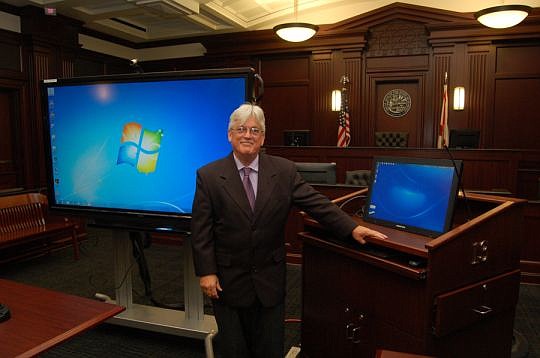
The days of attorneys flipping over pages on an easel after scribbling with a felt-tip marker to make a presentation during a trial are part of the past at the Duval County Courthouse.
That’s because all of the 51 courtrooms are equipped with the most up-to-date audio-visual technology.
“This is the most state-of-the-art courthouse in the state of Florida right now for presentation of evidence,” said Mike Smith, 4th Judicial Circuit trial court technology officer.
Having the latest technology makes it easier for counsel to present evidence and it makes sure the legal system is perceived as being what it should be.
“One of the attorneys who comes to the courthouse a lot explained to me that when jurors come into the courtroom, they expect a certain amount of technology because it’s what they have at home,” Smith said. “If you’re not close to what they expect, they think the courthouse is ancient and not up-to-date, so the decisions that are made here can’t possibly be up-to-date.”
The judiciary also is fully-wired in the courthouse when it comes to managing court functions, such as his or her docket.
“Anyone who has multiple places where they have to do their work — judges, magistrates and some other folks – are now on tablets. That allowed us to reduce our device count by almost 35 percent,” Smith said.
Judges used to have a desktop PC in their courtroom, one in their office and one in their hearing room.
“That was a lot more devices. Now we use a secure docking station that they plug into so they only have one device and one set of licenses (for software) that we have to pay for,” Smith added.
Each courtroom also is equipped with Americans with Disabilities Act-compliant assisted listening devices for people who are hearing-impaired.
And there’s a dedicated cellular antenna system for telephone communication and mobile device Internet access throughout the courthouse that was installed by service providers at no cost to the state, Smith said.
The next step for the high-tech courthouse is scheduled to be available later this year.
The system is called “Access to Justice Author.” It’s a cloud-based software tool that can make it easy for people who represent themselves within the judicial system and other non-technical authors to use a web-based interface to assemble court documents.
“We have the first pilot program in the state,” said Smith.
Certain post-judgment documents often used in family law, such as modifications and motions to vacate, will be available to the public online at the courthouse or on a litigant’s computer at home or even at the public library.
It also may eventually help people file documents related to evictions and uncontested divorce actions.
“Basically, it’s like TurboTax. Instead of coming to the courthouse and getting a clipboard with a bunch of printed paper, it will help build documents by asking questions, like name and address,” Smith said.
“If people can do that online, all they have to do is come in and verify who they are and verify what they did online was done correctly. If it isn’t, it’s an easy change. It’s another way to improve access to the courts and build public trust,” he added.
Having the system in place also will help the courts by reducing the number of hand-written documents and the court clerk won’t have to scan as many documents that need to be filed.
“The new process will allow documents to be just imported. It’s born digital and it resides digital,” Smith said.
Making the courthouse more accessible and user-friendly for everyone — not just those who work in the legal system — is the mission of everyone in the circuit, Smith said, and he and his three assistants use technology to make it as accessible and user-friendly as possible.
“The courthouse is a cornerstone of this community. When people come here, they need to know that justice is for everybody,” he said.
Duval County Courthouse technology by the numbers:
• Nearly 1,000 flat-screen video displays, including about 700 in courtrooms and hearing rooms
• More than 5,000 1-gigabyte ethernet ports
• 1,200 miles of twisted fiber strands
• 750 miles of copper cabling
• 610 miles of optical fiber cable
• Cellular dedicated antenna system with 42 nodes and 40 miles of low-loss coaxial cable
• 162 digital clocks
Source: 4th Judicial Circuit Court Technology Office
(904) 356-2466